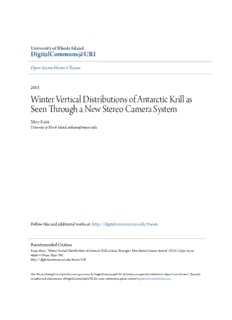
Winter Vertical Distributions of Antarctic Krill as Seen Through a New Stereo Camera System PDF
Preview Winter Vertical Distributions of Antarctic Krill as Seen Through a New Stereo Camera System
UUnniivveerrssiittyy ooff RRhhooddee IIssllaanndd DDiiggiittaallCCoommmmoonnss@@UURRII Open Access Master's Theses 2015 WWiinntteerr VVeerrttiiccaall DDiissttrriibbuuttiioonnss ooff AAnnttaarrccttiicc KKrriillll aass SSeeeenn TThhrroouugghh aa NNeeww SStteerreeoo CCaammeerraa SSyysstteemm Mary Kane University of Rhode Island, [email protected] Follow this and additional works at: https://digitalcommons.uri.edu/theses RReeccoommmmeennddeedd CCiittaattiioonn Kane, Mary, "Winter Vertical Distributions of Antarctic Krill as Seen Through a New Stereo Camera System" (2015). Open Access Master's Theses. Paper 592. https://digitalcommons.uri.edu/theses/592 This Thesis is brought to you for free and open access by DigitalCommons@URI. It has been accepted for inclusion in Open Access Master's Theses by an authorized administrator of DigitalCommons@URI. For more information, please contact [email protected]. WINTER VERTICAL DISTRIBUTIONS OF ANTARCTIC KRILL AS SEEN THROUGH A NEW STEREO CAMERA SYSTEM BY MARY KANE A THESIS SUBMITTED IN PARTIAL FULFILLMENT OF THE REQUIREMENTS FOR THE DEGREE OF MASTER OF SCIENCE IN OCEANOGRAPHY UNIVERSITY OF RHODE ISLAND 2015 MASTER OF SCIENCE IN OCEANOGRAPHY OF MARY KANE APPROVED: Thesis Committee: Major Professor: Susanne Menden-Deuer Christopher Roman Graham Forrester Nasser H. Zawia DEAN OF THE GRADUATE SCHOOL UNIVERSITY OF RHODE ISLAND 2015 Abstract: A new stereo camera system, encompassing a Sonde, acoustic Doppler current profiler (ADCP), and high-resolution-imaging cameras, was developed to improve our understanding of in situ Antarctic krill behaviors and distribution. Krill were observed on 18 deployments in 3 bays in the Western Antarctic Peninsula from May-June 2013. Observation conditions varied, including time of day, clear to stormy surface conditions, temperatures (-1.2ºC to 0.8ºC) and salinities (33.5ppt to 34.8ppt). Krill were observed in 61% of profiles. Krill distributions were found in two distinct profiles with regards to where highest abundances occurred: Type I profiles had maxima in the middle of the water column (200 to 350 meters), and Type II profiles had the greatest abundances at the bottom of the water column (200 to 800 meters). Occurrence of Type I and Type II profiles was strongly linked with time of day: Type I during dark and Type II during light periods. Krill were never observed shallower than 100m, indicating that krill reside deeper in the water column during the winter period. Acknowledgements: I would like to thank my major professor Susanne Menden-Deuer for her amazing mentorship, infinite patience, and the attentiveness she has given me in support of my work. This thesis was greatly improved by the critical review of Dr. S. Menden-Deuer, Dr. C. Roman, Dr. G. Forrester, Dr. B. Jenkins, and F. Morrison. Thank you to: Dr. G. Ingles, David Casagrande, Ian Vaughn, and Regina Yopak for their insight into and work with the krill camera system, and my lab mates Amanda Montalbano, Françoise Morrison, Mike Fong, and Sean Anderson for giving me critical feedback on this work. In addition, thank you to Captain John Souza and the crew of the RVIB Nathaniel B. Palmer, Drs. E. Durbin, T. Rynearson, M. Zhou, S. Menden-Deuer, and C. Roman, the science staff from the United States Antarctic Program, and all the volunteers and participants of the Seasonal Trophic Roles of Euphausia superba cruises. Funding for this project was provided to Drs. E. Durbin, T. Rynearson, M. Zhou, S. Menden-Deuer, and C. Roman by the National Science Foundation award no. 1142107 for the Seasonal Trophic Roles of Euphausia superba project. I also want to thank all my friends and family for their support and advice on this project. iii Preface: This thesis is written in manuscript style rather than using the traditional segregation of the thesis into chapters. The manuscript text is written in the formatting style appropriate for submission to the Journal of Plankton Research, and is followed by an appendix containing detailed, ancillary information regarding the image processing methodology and the analysis techniques used. iv TABLE OF CONTENTS ABSTRACT ………………………………………………………………………. ii ACKNOWLEDGEMENTS ……………………………………………………… iii PREFACE ………………………………………………………………………… iv TABLE OF CONTENTS ………………………………………………………… v LIST OF TABLES ………………………………………………………………... vii LIST OF FIGURES ………………………………………………………………. viii MANUSCRIPT I ………………………………………………………………….. 1 CHAPTER 1 ………………………………………………………………………. 2 INTRODUCTION …………………………………………………………. 2 CHAPTER 2 ………………………………………………………………………. 6 METHODS ………………………………………………………………… 6 CHAPTER 3 ………………………………………………………………………. 12 RESULTS ………………………………………………………………….. 12 CHAPTER 4 ………………………………………………………………………. 15 DISCUSSION ……………………………………………………………… 15 FIGURES AND TABLES ………………………………………………………... 22 APPENDIX …...…………………………………………………………………… 31 v REFERENCES…………………………………………………………………….. 42 vi LIST OF TABLES: TABLE PAGE Table 1. Deployment Number, Date, Time, Lat., Long, and Location ……………. 22 Table 2. Results of Model II Regression …………………………………….…….. 23 Table A.1. Details of Test Horizon Images ………………………………….…….. 31 vii LIST OF FIGURES: FIGURES PAGE Figure 1. Particles Identified as Krill by Algorithm to Visual Count of Krill ..……. 24 Figure 2. Comparison of Accuracy and Yield of Algorithm Parameter Values …… 25 Figure 3. Salinity and Temperature Profiles …………………...…………………... 27 Figure 4. Vertical Krill Profiles …..………………………………………………... 28 Figure 5. PAR at Time of Deployment to Relative Depth of Max Krill Abundance ……………………………………………………………………………………….. 29 Figure 6. Changes in Vertical Distribution of Krill Over Consecutive Dives…..….. 30 Figure A.2. Filter 1 Model II Regression Results ………………………………….. 32 Figure A.3. Filter 2 Model II Regression Results ………………………………….. 33 Figure A.4. Filter 3 Model II Regression Results ………………………………….. 34 Figure A.5. Number of Krill to Number of Blobs …………………………………. 35 Figure A.6. Percentage Composition of Objects Correctly Identified as Krill – Aspect Ratio ………………………………………………………………………… 36 Figure A.7. Percentage of Objects Identified as Krill – Aspect Ratio ……………... 37 Figure A.8. Percentage Composition of Objects Correctly Identified as Krill – Area ……………………………………………………………………………………….. 38 Figure A.9. Percentage of Objects Identified as Krill – Area ……………………… 39 Figure A.11. Covariance Coefficient of Krill Seen Over Time ……………………. 41 viii
Description: